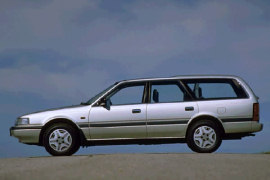MAZDA 626 Station Wagon Models/Series Timeline, Specifications & Photos
First production year: 1988
Engines: Gasoline
Body style: Wagon (station wagon, estate, combi, touring)
The fourth generation of the Mazda 626 Wagon was the middle road between a medium-sized hatchback and an MPV.
In the '80s, the MPV market-share was rising, but the station-wagon vehicles didn't give up the fight. Mazda already had a very appreciated model, the 626, so the Japanese carmaker placed its bets on the wagon.
With its rectangular, horizontal headlights and a shy try to soften its edges, the Mazda 6 wasn't everyone's candy. The Japanese carmaker didn't clearly understand the European's design taste, so it decided to try the market and convince it with good, well-built products. All four doors were kept the same as those installed on the hatchback version, and that resulted in an unusual shape for the side windows behind the C-pillars. In the back, the carmaker installed corner-mounted taillights to allow a straight cut for the tailgate. Unlike many other station-wagons on the market, it featured a flat floor, flush to the top rear bumper.
Inside, the Japanese designers installed a curved dashboard with a hump above the instrument cluster. It didn't feature the usual angled cuts from most of its competitors on the market. The air-vents were integrated into the center stack and above the median line of the dash. For some trim levels, it featured front bucket seats. In the rear, Mazda installed a folding rear seatback to expand the trunk area.
The independent suspension in all corners made the car very comfortable, and the engine lineup was adequate for its customers. Mazda offered a choice of diesel and gasoline engines for the 626.
